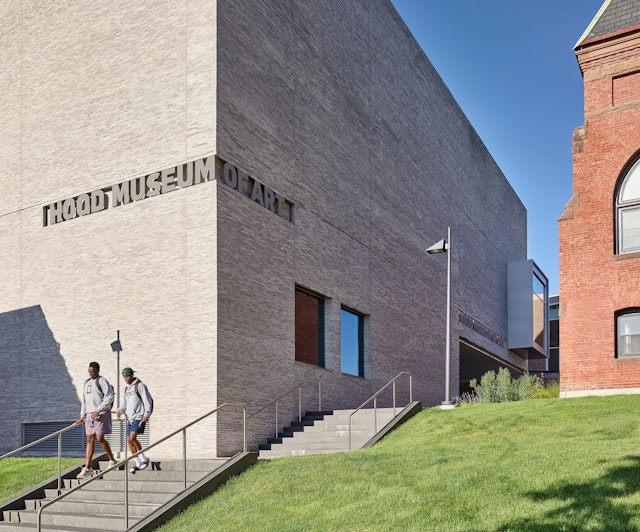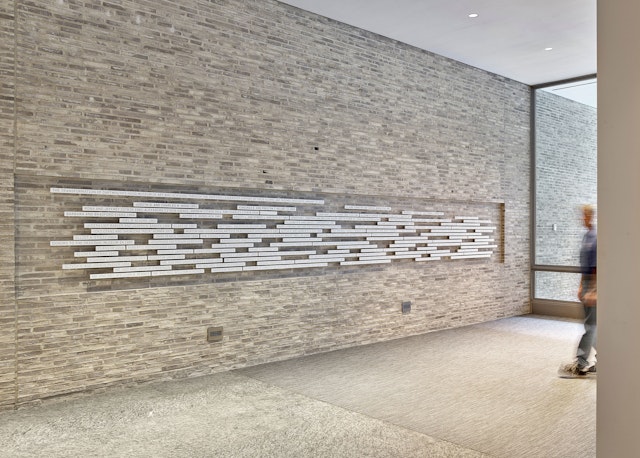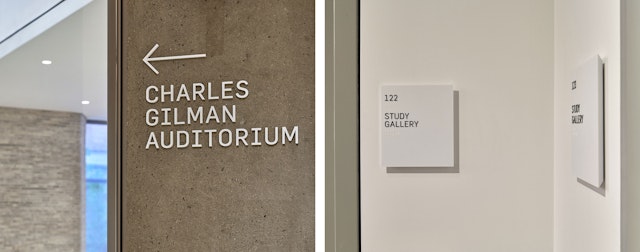
The identity takes its cues from the clarity and geometry of the architecture.






The geometric yet organic sans serif scales well, from the building’s façade to the small cubic form of the logo.










The Hood Museum of Art at Dartmouth College in Hanover, New Hampshire, is one of the oldest and largest university art collections in the US. Founded in 1772, the institution is home to 65,000 objects that include important holdings of European Old Masters, American, Native American, African and Indian art. Pentagram designed a new visual identity and environmental graphics for the museum that coincides with a major expansion and renovation by Tod Williams Billie Tsien Architects. The project integrates the identity throughout the museum, from the façade of the new building to institutional communications including the website and Hood Quarterly, the members’ magazine.
Pentagram worked closely with the Hood leadership and the architects on the project. The TWBTA expansion occupies the courtyard space of the postmodernist building designed in 1985 by Charles W. Moore and Chad Floyd (of Centerbrook Architects). The project adds 42 percent more space (for a total of 62,400 sq ft) that includes a reimagined entrance and multipurpose lobby, additional galleries, classrooms and administrative offices, and a new auditorium.
The Hood is a historically important teaching museum, known for its strong, gallery-based art history program, which offers Dartmouth students and faculty access to the entire collection via the Hood’s Bernstein Center for Object Study. The renovation transforms the experience of the galleries and museum as a whole to encourage engagement between visitors, works of art and the surrounding campus.
The new identity is an important part of this strategy, providing a cohesive experience across spatial, digital and promotional communications. The goal was to create a graphic program that could be maintained by a relatively small design staff, while providing a visual language that is closely aligned with the character of the building.
The new Hood building is an abstract cubic volume of off-white handmade brick that asserts its presence within the traditional setting of Dartmouth’s historic Ivy League campus. Like the architecture, the visual identity needed to work with both historical and contemporary art, spanning multiple cultures. The identity takes its cues from the clarity and geometry of the architecture. The light brick façade and rectilinear forms of the building inspired a brick-like graphic motif that carries from the logo to the modular structure and layouts of the publications and the website.
The typographic voice is modern, centered around a wordmark set in Flama, designed by Mario Feliciano. The geometric yet organic sans serif scales well, from the building’s façade to the small cubic form of the logo. Supporting typography draws on the large Flama type family, as well as Velino. The identity’s palette is largely monochromatic, inspired by the white and light gray of the hand-formed Petersen bricks used in the building’s façade.
The architecture embraces the identity as a critical element of the facade: the letters, made of glass-fiber reinforced concrete, are integrated within a carefully constructed channel. The letterforms are exceptionally thin and lit from behind to be seen in shadow at night. Above the main entrance, the marquee signage appears as a simple horizontal line that points towards the “vitrine,” a distinctive 14-foot-square opening that juts out from the second floor. The other two moments bend into and around corners, breaking the phrase “HOOD MUSEUM OF ART” into separate components, visible from different points of approach.
The designers also developed a system of identification, wayfinding and donor-recognition signage throughout the building, including a sculptural 24 1/2-foot-long donor wall in the lobby. Inset in a recess like the signage on the facade, the installation presents donor names on pin-mounted Corian panels, arranged in a grid-like pattern that echoes the scale and rhythm of the brickwork. Names are engraved into the surface of the bars, with hierarchy indicated through type weight and color.
Pentagram previously collaborated with TWBTA on the new home for the Barnes Foundation in Philadelphia.
Client
Hood Museum of ArtSector
- Arts & Culture
Discipline
- Brand Identity
- Signage & Environmental Graphics
- Digital Experiences
